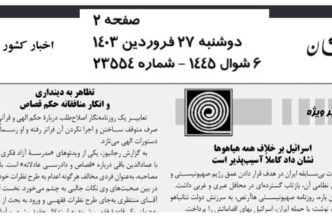Emadedin Baghi
Editorial of Sazendagi newspaper, NO 1639, Thursday, Feb 15, 2024
If fictional films like “Trip to the Moon” (1902), “The Outbreak” (1995), “The Flu» (2013) and the like became reality years after their release, can apocalyptic films about the destruction of the world and the end of humanity like “2012” (2009), “World War Z” (2013), “The Snowpiercer” (2013) and dozens of other films also become reality?
In 1993, digital technology was not yet globalized and had not yet reached countries like ours, and the idea of a digital world was an incredible dream. Despite Alvin Toffler’s predictions in The Third Wave and The Future Shock, many people (especially in societies furthest away from the developments of new technologies) saw these as dreams in the style of Jules Verne’s stories. I also had a critique of Toffler’s optimistic views. My views were published in Salam Daily on December 12 and 26, 1993 under the title “Critique of the Third Transformation Theory”. Later, this article became a chapter of the book “The Birth of a Revolution”. In it, I criticized Toffler’s prediction that the world was moving towards coexistence and peace in the digital world and wrote: “Colonial relations in their present form may be dissolved, but they will not be replaced by a utopia; rather, cruel relations may take on new forms. Sleep bombs are currently being tested to put the enemy to sleep before he finds an opportunity to shoot. Instead of dropping an atomic bomb that destroys a city, virialization can wipe out a nation or nations and cause terror without the warmonger having to enter the battlefield. New ways of colonization, exploitation, wars and killing are thus organized shoulder to shoulder with the developments taking place.”
After the bloody revolutions and wars of the 18th and 19th centuries in America and Europe and finally the First and Second World Wars, the birth of the United Nations and the Universal Charter of Human Rights gave rise to great hope for a world of peace. But today, just 75 years after the Universal Declaration of Human Rights, the logic of violence and its overcoming of human rights in the world is more evident than ever before. While the devastating Vietnam War by the USA and the occupation of Afghanistan by the Soviet Union were thought to be the last of the 20th century, they have been brought to light by observing events in Sudan, Yemen and some African countries, as well as the attack on the Twin Towers at the beginning of the 21st century. We have seen the invasions of the USA and NATO in Afghanistan, Iraq and Libya and the attacks by the Arab-Western coalition on the Houthis in Yemen, and now the China-Taiwan and Tibet crises, the crisis of the North Korean nuclear dictatorship and its threats, the assassination of a high-ranking Iranian military officer (who, according to official sources, had traveled from Baghdad to Iraq to deliver a message of peace to Saudi Arabia) on the basis of an order from Trump in a third country and his appreciation of this assassination, Assad’s assassination in Syria, Russia’s occupation of Crimea and Ukraine, the tragedies unfolding before the eyes of the world in Gaza today, Yemen’s support for Gaza and the Western coalition’s airstrikes on Yemen, Turkey’s attacks on the Syrian Kurds, Israel’s airstrikes on Lebanon and Syria, Iran’s missile attacks on Erbil, Syria and rural Pakistan, Pakistan’s counter-attacks, Azerbaijan’s attack on Karabakh, the American attacks on bases in Iraq and Syria, Western governments’ support for Sisi’s coup in Egypt despite thousands of political prisoners and those sentenced to death, and other examples that are not mentioned here, show that it is easy to violate borders and international law, and that the credibility of the international laws and institutions has been undermined and that might is right.
Today, in a world where nuclear bombs can destroy the world many times over, we are confronted with a frightening reality through the observation of drones and self-propelled aircrafts, a reality that has violated all documents of human rights and humanitarian laws. If ever there were protests and concerns about the double standards of human rights and the existence of good and bad terrorism and the like, we are now faced with robots that simply kill people. The Americans are using drones to terrorize their enemies. We have heard these days that the Israelis are using drones in Beirut to assassinate Hezbollah or Hamas members. We have heard that the Israeli war machine is using AI to direct operations in Gaza, and experts have identified AI as one of the factors attacking civilian targets and killing civilians.
Legendary new age technologies are at the service of governments and powers that confront the world with modern and complex forms of widespread human rights violations. Censorship has also become more sophisticated. For example, bots are used to block many websites based solely on the selection of certain keywords and images. True, a company called Coda Story was created that caused Instagram to publish a post of mine on Instagram, which was deleted by Instagram several times. However, we cannot ignore the fact that in this new world, the style of censorship has also changed.
While the Universal Declaration of Human Rights was adopted at the beginning of the 20th century to show us the way to a world of peace and tolerance, today these documents are history and new laws need to be passed. The European Union has passed the first law on AI, but this is just the beginning. AI will drive domino-like developments for which humanity is still a long way from legislating. It seems that there will only be a global law like the Charter of Human Rights when we are faced with a threat as great as that of the Second World War.
What makes achieving a world of peace and tranquility in an AI world even more unattainable is the resistance it will face from global powers. Will the world’s major powers accept the passing of laws restricting the unbridled use of drones for assassination? The evidence shows that there will be no such rules until the world feels threatened by dangers similar to those of the First and Second World Wars.
The second part of the article in next week’s issue
https://t.me/emadbaghi
www.emadbaghi.com
https://instagram.com/emadeddinbaghi
https://facebook.com/Emadbaqi





